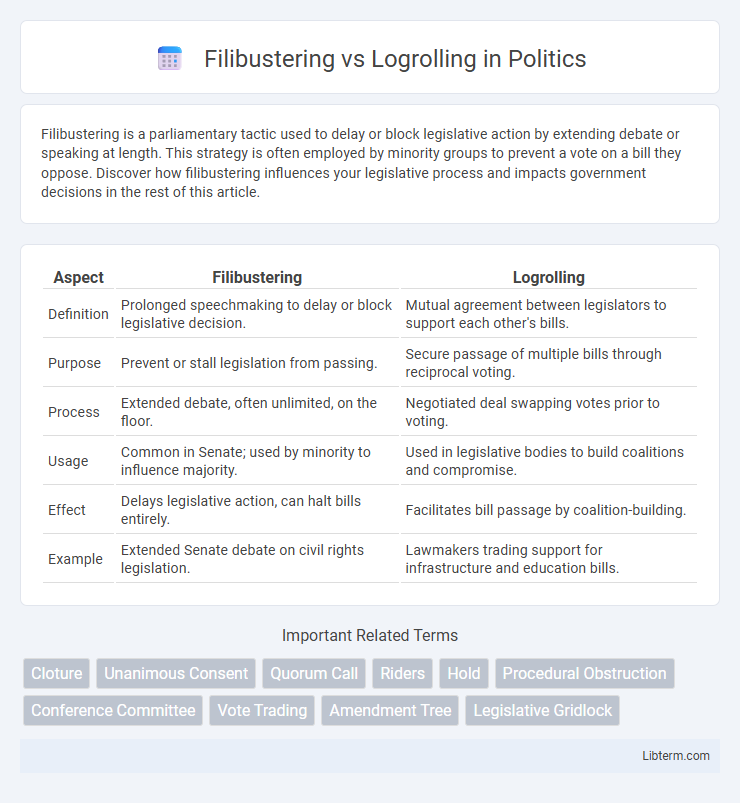Filibustering is a parliamentary tactic used to delay or block legislative action by extending debate or speaking at length. This strategy is often employed by minority groups to prevent a vote on a bill they oppose. Discover how filibustering influences your legislative process and impacts government decisions in the rest of this article.
Table of Comparison
| Aspect | Filibustering | Logrolling |
|---|---|---|
| Definition | Prolonged speechmaking to delay or block legislative decision. | Mutual agreement between legislators to support each other's bills. |
| Purpose | Prevent or stall legislation from passing. | Secure passage of multiple bills through reciprocal voting. |
| Process | Extended debate, often unlimited, on the floor. | Negotiated deal swapping votes prior to voting. |
| Usage | Common in Senate; used by minority to influence majority. | Used in legislative bodies to build coalitions and compromise. |
| Effect | Delays legislative action, can halt bills entirely. | Facilitates bill passage by coalition-building. |
| Example | Extended Senate debate on civil rights legislation. | Lawmakers trading support for infrastructure and education bills. |
Introduction to Filibustering and Logrolling
Filibustering is a parliamentary procedure where a legislator extends debate to delay or prevent a vote on a proposal, often used strategically in the U.S. Senate to block legislation. Logrolling involves legislators exchanging support for each other's bills or amendments, creating mutually beneficial agreements to secure passage. Both tactics influence legislative decision-making by affecting how votes are negotiated and when laws advance.
Historical Origins of Filibustering
Filibustering originated in the 19th-century United States Senate as a tactic to delay or block legislative action by extending debate indefinitely. This practice was historically linked to efforts by Southern senators to oppose civil rights legislation and maintain regional interests. Filibustering relies on procedural rules allowing unlimited speaking time, contrasting with logrolling, which involves mutual vote trading to secure policy concessions.
The Evolution of Logrolling in Legislative Processes
Logrolling has evolved into a strategic legislative practice where lawmakers exchange support for each other's bills to secure mutual benefits, enhancing coalition-building within parliaments. Unlike filibustering, which obstructs legislative progress through prolonged debate, logrolling facilitates negotiation and compromise, enabling smoother passage of diverse policy measures. Modern legislative bodies increasingly rely on logrolling to balance competing interests and expedite decision-making while maintaining political alliances.
Key Differences Between Filibustering and Logrolling
Filibustering involves prolonged speechmaking in legislative assemblies to delay or prevent a decision on a proposal, primarily used as a procedural tactic to block legislation. Logrolling refers to the practice where legislators exchange support by agreeing to vote for each other's proposals, facilitating mutual benefit and coalition-building. Key differences include filibustering as a delaying strategy aimed at obstruction, while logrolling operates through negotiated cooperation to advance multiple bills.
Legal and Procedural Aspects of Filibustering
Filibustering is a legislative procedure that allows senators to extend debate indefinitely to delay or block a vote, governed by Senate rules and requiring a cloture motion with a three-fifths majority to end debate. Logrolling involves the trading of votes between legislators to gain mutual support for bills, relying on negotiation rather than formal procedural rules. The legal framework of filibustering emphasizes limits on debate and the need for procedural consensus, whereas logrolling operates primarily through informal agreements and political strategy.
Logrolling Techniques in Modern Politics
Logrolling techniques in modern politics involve legislators exchanging support for each other's bills to secure mutual benefits, often seen in budget allocations and policy decisions. This strategic vote trading enables coalition-building and passage of measures that might otherwise fail due to divided interests. By leveraging reciprocal agreements, lawmakers maximize legislative efficiency and political capital while advancing their specific agendas.
Impact of Filibustering on Legislative Outcomes
Filibustering significantly delays or blocks the passage of legislation by extending debate time, often preventing a vote when minority lawmakers oppose a bill. This tactic can shift legislative outcomes by forcing compromises or concessions to overcome the filibuster threshold, usually requiring 60 Senate votes to end debate. Consequently, filibustering shapes policy decisions and legislative efficiency, influencing the balance of power within the U.S. Senate.
Ethical Considerations in Filibustering and Logrolling
Filibustering raises ethical concerns due to its potential to obstruct legislative progress and override majority rule, often allowing a minority to impede important policy decisions. Logrolling, involving the exchange of votes to secure mutual benefits, poses ethical challenges because it can promote favoritism and undermine transparent, merit-based decision-making. Both practices highlight the tension between strategic legislative behavior and the principles of democratic fairness and accountability.
Famous Filibusters and Notable Logrolling Incidents
The 1957 filibuster by Senator Strom Thurmond lasted 24 hours and 18 minutes, aiming to block the Civil Rights Act, marking one of the most famous filibusters in U.S. history. Notable logrolling incidents include the "Bridge to Nowhere" deal in the early 2000s, where lawmakers exchanged votes to fund controversial projects. These tactics reflect critical legislative strategies used to influence policy outcomes and shape government spending priorities.
The Future of Filibustering and Logrolling in Governance
The future of filibustering in governance faces increasing scrutiny as legislative gridlock prompts calls for reform to enhance efficiency and accountability. Emerging proposals advocate for limiting filibuster use or instituting stricter time constraints to balance minority rights with legislative productivity. Simultaneously, logrolling continues to evolve as a strategic negotiation tool, with digital transparency tools potentially reducing opaque vote trading while preserving coalition-building dynamics in policymaking.
Filibustering Infographic

 libterm.com
libterm.com